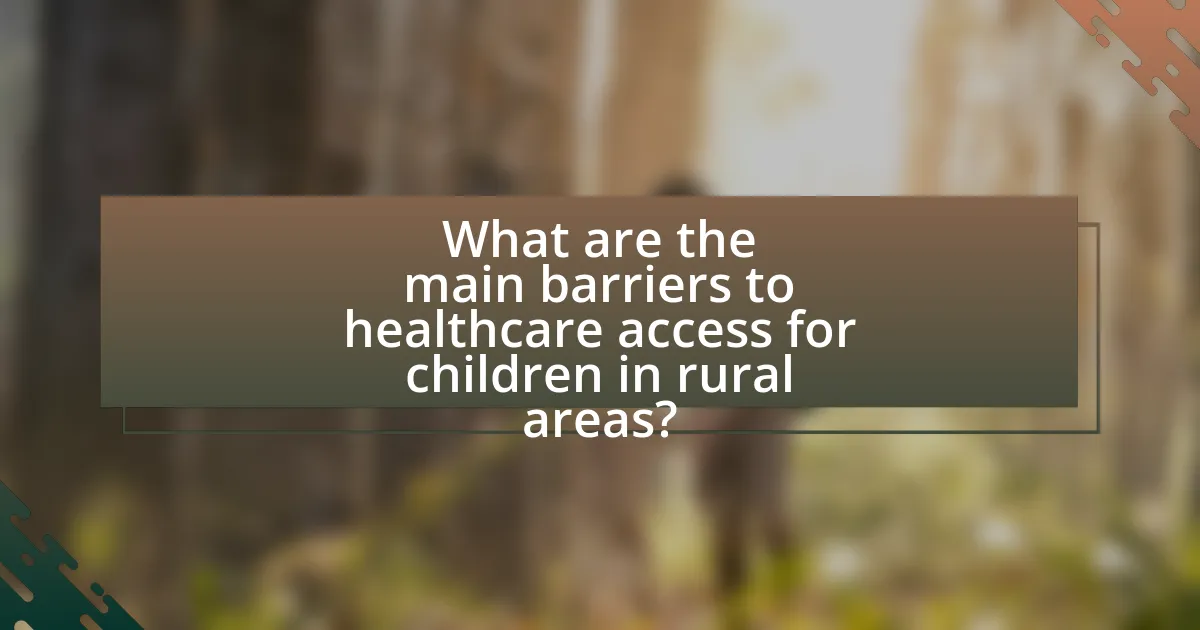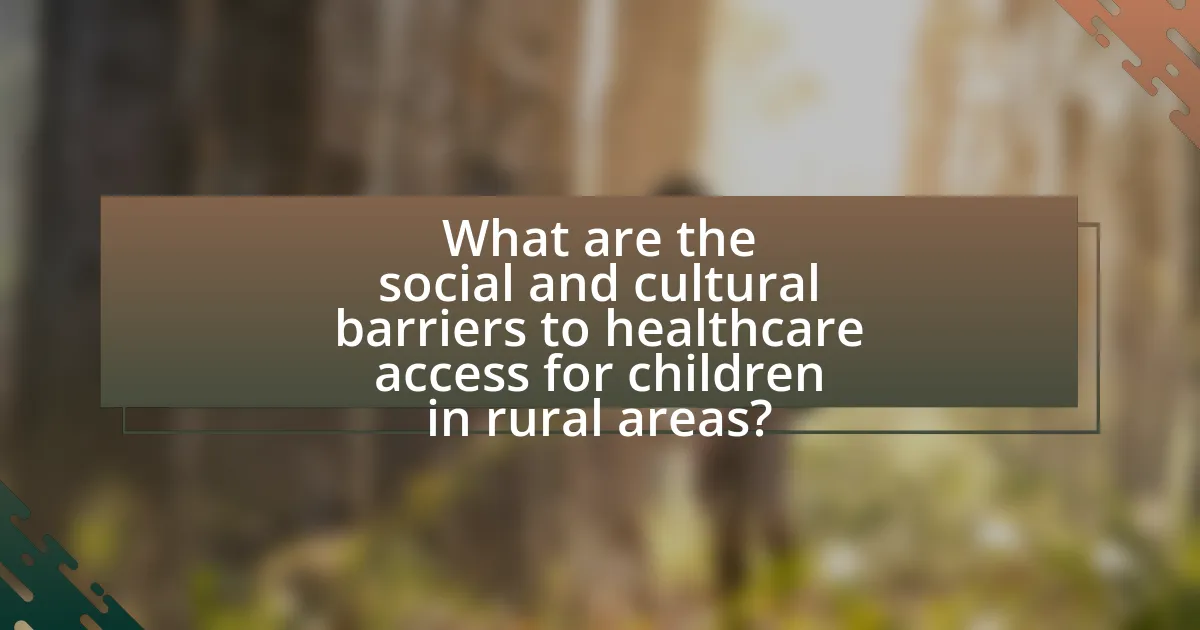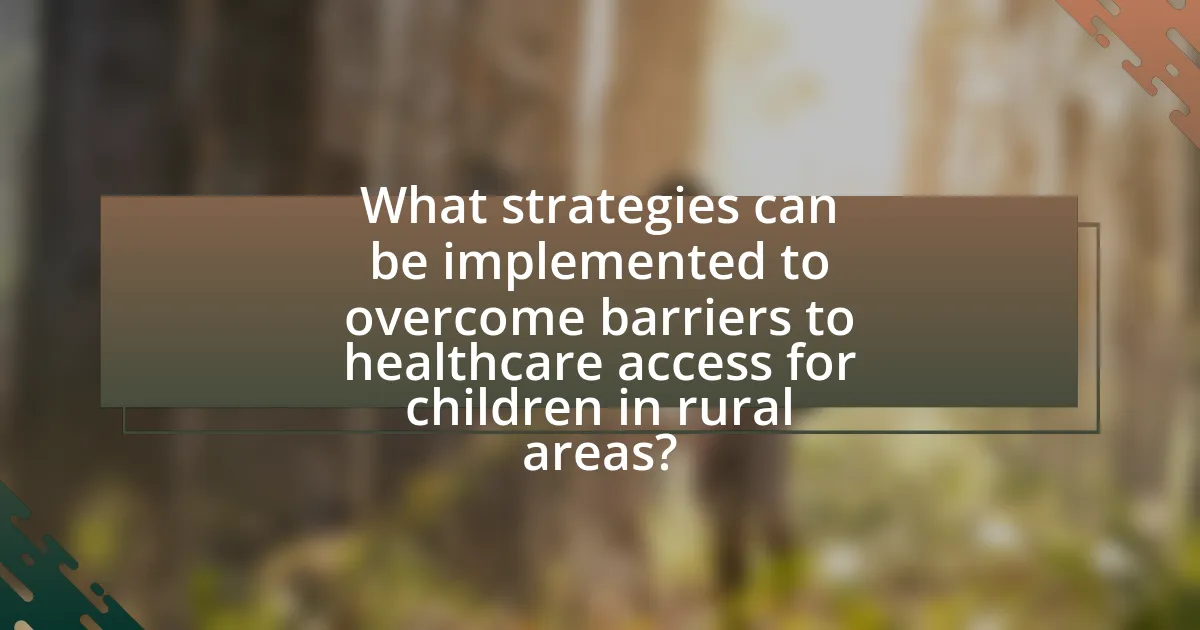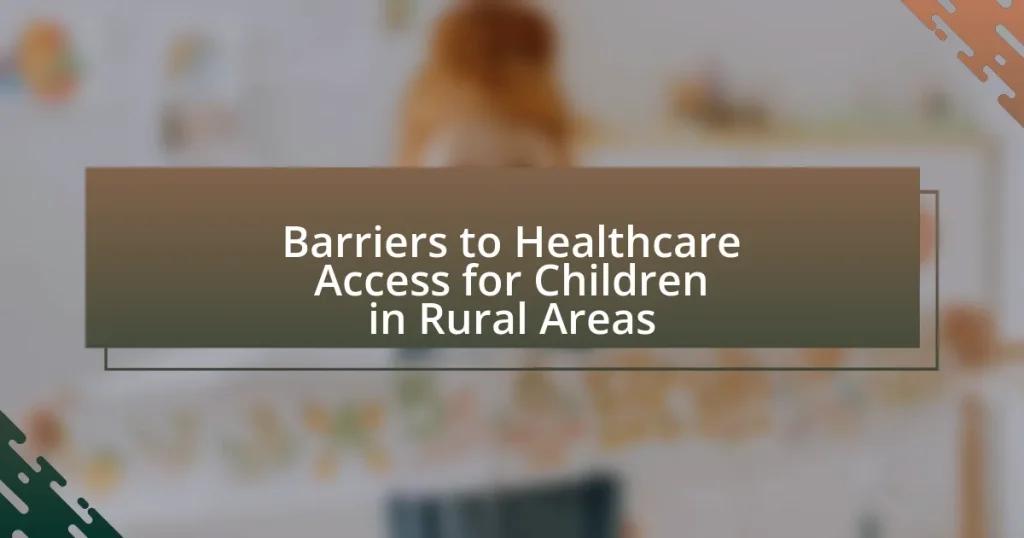The article examines the barriers to healthcare access for children in rural areas, highlighting key challenges such as limited healthcare facilities, transportation issues, and a shortage of healthcare professionals. It discusses how geographical factors, economic challenges, and social stigma further complicate access to necessary medical services. The article also explores the impact of parental education on healthcare utilization, the role of telehealth and community initiatives in improving access, and the importance of collaboration between healthcare providers and local organizations. Overall, it provides a comprehensive overview of the multifaceted obstacles faced by families in rural settings when seeking healthcare for their children.

What are the main barriers to healthcare access for children in rural areas?
The main barriers to healthcare access for children in rural areas include limited availability of healthcare facilities, transportation challenges, and a shortage of healthcare professionals. Rural areas often have fewer hospitals and clinics, which can lead to long travel distances for families seeking care. According to the National Rural Health Association, rural communities face a higher rate of healthcare provider shortages, with many areas lacking pediatric specialists. Additionally, inadequate public transportation options further complicate access, as families may struggle to reach distant healthcare services. These factors collectively hinder timely and effective healthcare for children in these regions.
How do geographical factors impact healthcare access for children in rural areas?
Geographical factors significantly hinder healthcare access for children in rural areas by creating physical barriers and limiting the availability of medical services. Rural locations often have fewer healthcare facilities, leading to longer travel distances for families seeking care; for instance, a study by the National Rural Health Association found that rural residents may travel over 30 miles to reach a primary care provider. Additionally, sparse populations in these areas result in a shortage of healthcare professionals, with the Health Resources and Services Administration reporting that rural areas have only 39 primary care physicians per 100,000 people compared to 82 in urban settings. These geographical challenges contribute to delayed treatment and poorer health outcomes for children in rural communities.
What role does distance to healthcare facilities play in access issues?
Distance to healthcare facilities significantly impacts access issues, particularly for children in rural areas. Longer distances can lead to delays in receiving care, increased transportation costs, and reduced likelihood of seeking necessary medical attention. Research indicates that families living more than 30 minutes from a healthcare provider are less likely to utilize preventive services, which can exacerbate health disparities. For instance, a study published in the Journal of Rural Health found that children in rural settings face a 25% higher risk of unmet healthcare needs due to distance compared to their urban counterparts. This evidence underscores the critical role that proximity to healthcare facilities plays in ensuring timely and adequate healthcare access for children in these underserved regions.
How does transportation availability affect children’s healthcare access?
Transportation availability significantly impacts children’s healthcare access by determining their ability to reach medical facilities. In rural areas, where healthcare services are often located far from homes, limited transportation options can lead to missed appointments and delayed treatments. A study by the National Rural Health Association found that 30% of rural families reported transportation as a barrier to accessing healthcare for their children. This lack of reliable transportation can exacerbate health disparities, as children in these areas may not receive timely vaccinations, routine check-ups, or emergency care, ultimately affecting their overall health outcomes.
What economic challenges do families face in rural areas regarding healthcare?
Families in rural areas face significant economic challenges regarding healthcare, primarily due to limited access to affordable services and higher transportation costs. Rural families often encounter fewer healthcare providers, leading to increased travel distances for medical care, which can strain their financial resources. According to the Rural Health Research Center, rural residents are more likely to experience higher out-of-pocket expenses for healthcare services compared to their urban counterparts, exacerbating financial burdens. Additionally, lower average incomes in rural areas contribute to difficulties in affording necessary healthcare, as families may prioritize basic needs over medical expenses. These economic factors collectively hinder access to essential healthcare services for families living in rural regions.
How do income levels influence healthcare access for children?
Income levels significantly influence healthcare access for children, as families with lower incomes often face financial barriers that limit their ability to obtain necessary medical services. Research indicates that children from low-income households are more likely to be uninsured or underinsured, which directly affects their access to preventive care, treatments, and specialist services. For instance, a study published in the Journal of Pediatrics found that children in families earning below the federal poverty level are 2.5 times more likely to experience unmet healthcare needs compared to those from higher-income families. This disparity highlights how income levels create obstacles to timely and adequate healthcare for children, particularly in rural areas where healthcare resources may already be limited.
What are the costs associated with healthcare that families in rural areas struggle with?
Families in rural areas struggle with high healthcare costs, including transportation expenses, out-of-pocket medical expenses, and limited access to affordable insurance options. Transportation costs arise because rural families often need to travel long distances to reach healthcare facilities, which can lead to significant fuel and time expenditures. Out-of-pocket medical expenses can be burdensome due to fewer local providers, resulting in higher costs for services and medications. Additionally, rural areas frequently have limited insurance options, leading to higher premiums and deductibles, which further exacerbates the financial strain on families seeking necessary healthcare services.
How does the availability of healthcare providers affect access for children?
The availability of healthcare providers significantly impacts access for children by determining the ease with which families can obtain necessary medical services. In rural areas, a shortage of healthcare providers often leads to longer travel distances, increased wait times, and limited appointment availability, which can deter families from seeking care. For instance, a study published in the Journal of Rural Health found that children in rural regions are 30% less likely to receive timely vaccinations compared to their urban counterparts, primarily due to inadequate access to healthcare providers. This lack of availability can result in unmet health needs, contributing to poorer health outcomes for children in these communities.
What types of healthcare professionals are lacking in rural areas?
Rural areas are particularly lacking in primary care physicians, mental health professionals, and pediatric specialists. According to the Health Resources and Services Administration (HRSA), rural regions often experience a shortage of healthcare providers, with many counties classified as Health Professional Shortage Areas (HPSAs). This shortage significantly impacts children’s access to necessary healthcare services, as fewer pediatricians and mental health providers are available to meet their needs.
How does the shortage of pediatric specialists impact children’s health outcomes?
The shortage of pediatric specialists negatively impacts children’s health outcomes by limiting access to necessary medical care and specialized treatments. This lack of access can lead to delayed diagnoses, inadequate management of chronic conditions, and poorer overall health status among children. For instance, a study published in the journal “Pediatrics” found that children living in areas with fewer pediatric specialists experienced higher rates of preventable hospitalizations and worse health outcomes compared to those in regions with adequate specialist availability. Additionally, the American Academy of Pediatrics reports that rural areas often face significant barriers, including longer travel distances to receive care, which can exacerbate health disparities and hinder timely interventions.

What are the social and cultural barriers to healthcare access for children in rural areas?
Social and cultural barriers to healthcare access for children in rural areas include stigma, lack of awareness, and cultural beliefs that prioritize alternative medicine over conventional healthcare. Stigma surrounding mental health and certain medical conditions can prevent families from seeking necessary care for their children. Additionally, a lack of awareness about available healthcare services and preventive care options can lead to underutilization of healthcare resources. Cultural beliefs may also influence perceptions of healthcare, with some families favoring traditional practices, which can further limit access to essential medical services. These barriers contribute to disparities in health outcomes for children living in rural communities.
How do cultural beliefs and practices influence healthcare-seeking behavior?
Cultural beliefs and practices significantly influence healthcare-seeking behavior by shaping individuals’ perceptions of health, illness, and medical interventions. For instance, in many cultures, traditional healing practices are preferred over modern medicine, leading to delays in seeking professional healthcare. A study published in the Journal of Health and Social Behavior found that cultural stigma surrounding mental health issues can deter individuals from seeking necessary care, particularly in rural areas where access to mental health services is limited. Additionally, beliefs about the efficacy of certain treatments can lead families to prioritize alternative remedies, impacting timely access to healthcare for children.
What misconceptions about healthcare exist in rural communities?
Misconceptions about healthcare in rural communities include the belief that healthcare services are readily available and that local providers can meet all medical needs. Many residents assume that they can access specialized care without traveling long distances, which is often not the case. According to the National Rural Health Association, rural areas face significant shortages of healthcare professionals, leading to limited access to specialized services. Additionally, some individuals in these communities may think that health insurance is unnecessary due to perceived low healthcare costs, which can result in underinsurance or lack of coverage altogether. This misconception can hinder access to necessary medical care, as uninsured individuals are less likely to seek treatment.
How does stigma affect children’s access to healthcare services?
Stigma significantly hinders children’s access to healthcare services by creating an environment of fear and shame around seeking medical help. This stigma can arise from various sources, including societal attitudes towards certain health conditions, socioeconomic status, or cultural beliefs. For instance, children with mental health issues may avoid seeking care due to the fear of being labeled or judged, which can lead to untreated conditions and worsening health outcomes. Research indicates that stigma can result in lower healthcare utilization rates; a study published in the Journal of Adolescent Health found that adolescents with mental health concerns were less likely to access services due to perceived stigma. Thus, stigma directly correlates with reduced healthcare access for children, particularly in rural areas where resources are already limited.
What role does education play in healthcare access for children in rural areas?
Education significantly influences healthcare access for children in rural areas by equipping families with knowledge about available health services and promoting health literacy. Higher levels of education among parents correlate with increased awareness of healthcare resources, leading to more proactive health-seeking behaviors. For instance, a study published in the Journal of Rural Health found that educated parents are more likely to utilize preventive healthcare services for their children, thereby improving overall health outcomes. Additionally, educational programs can bridge gaps in understanding complex healthcare systems, making it easier for families in rural settings to navigate and access necessary medical care.
How does parental education level impact children’s healthcare access?
Parental education level significantly impacts children’s healthcare access by influencing their understanding of health information and navigation of healthcare systems. Parents with higher education levels are more likely to recognize the importance of preventive care, seek timely medical attention, and utilize available healthcare resources effectively. Research indicates that children of educated parents have better access to healthcare services, as these parents are often more aware of health insurance options and community resources. For instance, a study published in the Journal of Health and Social Behavior found that children whose parents had at least a college degree were 30% more likely to receive regular check-ups compared to those whose parents had lower educational attainment. This correlation highlights the critical role that parental education plays in shaping children’s healthcare access.
What initiatives can improve health literacy in rural communities?
Initiatives that can improve health literacy in rural communities include community-based education programs, telehealth services, and partnerships with local organizations. Community-based education programs, such as workshops and health fairs, provide tailored information that addresses specific health concerns prevalent in rural areas. Telehealth services enhance access to healthcare information and professional guidance, overcoming geographical barriers. Partnerships with local organizations, such as schools and churches, facilitate the dissemination of health information and resources, ensuring that messages reach diverse populations effectively. These initiatives have been shown to increase knowledge and understanding of health issues, ultimately leading to better health outcomes in rural communities.

What strategies can be implemented to overcome barriers to healthcare access for children in rural areas?
To overcome barriers to healthcare access for children in rural areas, implementing telehealth services is essential. Telehealth can bridge the gap between healthcare providers and families by allowing remote consultations, which reduces travel time and costs associated with accessing care. A study published in the Journal of Rural Health found that telehealth significantly increased access to pediatric care in rural communities, demonstrating a 30% increase in follow-up appointments for children who utilized these services. Additionally, establishing mobile health clinics can provide on-site services, further enhancing accessibility. These strategies collectively address the geographical and logistical challenges faced by families in rural settings.
How can telehealth services improve access to healthcare for rural children?
Telehealth services can significantly improve access to healthcare for rural children by providing remote consultations and reducing the need for travel to healthcare facilities. This is particularly important in rural areas where healthcare providers are scarce; for instance, the Health Resources and Services Administration reports that rural areas have 39% fewer primary care physicians per capita compared to urban areas. Telehealth allows children to receive timely medical advice, follow-up care, and mental health services from the comfort of their homes, which can lead to better health outcomes. Additionally, studies show that telehealth can increase appointment adherence rates, as families face fewer logistical challenges, such as transportation and time off work, thus ensuring that rural children receive necessary healthcare services more consistently.
What are the benefits of telehealth for pediatric care in rural settings?
Telehealth significantly enhances pediatric care in rural settings by improving access to healthcare services. In rural areas, children often face geographical barriers that limit their access to specialized medical care. Telehealth mitigates these challenges by allowing remote consultations, which can reduce travel time and associated costs for families. A study published in the Journal of Telemedicine and Telecare found that telehealth services increased access to pediatric specialists by 50% in rural communities, demonstrating its effectiveness in bridging the healthcare gap. Additionally, telehealth facilitates timely interventions, which are crucial for managing chronic conditions in children, ultimately leading to better health outcomes.
What challenges exist in implementing telehealth solutions?
Implementing telehealth solutions faces several challenges, including technological barriers, regulatory issues, and disparities in access. Technological barriers arise from inadequate internet connectivity in rural areas, where approximately 19 million Americans lack access to high-speed internet, limiting the effectiveness of telehealth services. Regulatory issues include varying state laws regarding telehealth practices, which can complicate provider licensing and reimbursement processes. Additionally, disparities in access to devices and digital literacy among families can hinder the adoption of telehealth, particularly for children in rural areas, where socioeconomic factors may limit access to necessary technology.
What community-based initiatives can enhance healthcare access for children?
Community-based initiatives that can enhance healthcare access for children include mobile health clinics, school-based health programs, and community health worker outreach. Mobile health clinics provide essential services directly to underserved areas, reducing transportation barriers; for instance, a study by the National Association of Community Health Centers found that mobile clinics significantly increase access to preventive care for children in rural settings. School-based health programs integrate healthcare services within educational institutions, allowing children to receive care without missing school, which has been shown to improve health outcomes and attendance rates. Community health workers serve as liaisons between families and healthcare providers, offering education and support, which has been validated by research indicating that such initiatives can lead to increased immunization rates and better management of chronic conditions among children in rural communities.
How can local organizations support families in accessing healthcare services?
Local organizations can support families in accessing healthcare services by providing transportation assistance, facilitating health education programs, and connecting families with local healthcare resources. For instance, organizations can offer shuttle services to medical appointments, which addresses the transportation barrier often faced in rural areas. Additionally, health education initiatives can inform families about available services and preventive care, improving health literacy. Research indicates that community health workers can effectively bridge gaps in healthcare access by linking families to necessary services, thereby enhancing overall health outcomes for children in rural settings.
What role do schools play in facilitating healthcare access for children?
Schools serve as critical access points for healthcare services for children, particularly in rural areas where healthcare resources may be limited. They often provide health education, screenings, and referrals to healthcare providers, thereby bridging the gap between children and necessary medical services. For instance, school-based health centers have been shown to improve access to care, with studies indicating that students who utilize these centers are more likely to receive preventive services and manage chronic conditions effectively. Additionally, schools can facilitate partnerships with local health organizations, enhancing the availability of services such as immunizations and mental health support directly on campus.
What best practices can be adopted to improve healthcare access for children in rural areas?
To improve healthcare access for children in rural areas, implementing telemedicine services is essential. Telemedicine allows healthcare providers to deliver care remotely, reducing travel barriers for families in isolated regions. A study by the American Academy of Pediatrics found that telehealth can significantly increase access to pediatric care, with a reported 50% increase in consultations in rural settings after telemedicine implementation. Additionally, establishing mobile health clinics can further enhance access by bringing services directly to communities, addressing the lack of local healthcare facilities. These practices not only improve healthcare access but also ensure timely interventions for children’s health needs.
How can collaboration between healthcare providers and community organizations enhance access?
Collaboration between healthcare providers and community organizations enhances access by creating a network that addresses the specific needs of rural populations. This partnership allows for the sharing of resources, knowledge, and services, which can lead to improved health outcomes. For instance, community organizations can facilitate outreach programs that educate families about available healthcare services, while healthcare providers can offer mobile clinics or telehealth options to reach underserved areas. Research indicates that such collaborations can reduce barriers like transportation and awareness, ultimately increasing healthcare utilization among children in rural areas.
What policies can be advocated to support healthcare access for rural children?
Policies that can be advocated to support healthcare access for rural children include expanding telehealth services, increasing funding for rural health clinics, and implementing mobile health units. Expanding telehealth services allows children in remote areas to receive medical consultations without the need for travel, addressing geographical barriers. Increasing funding for rural health clinics ensures that these facilities can provide essential services and attract healthcare professionals, which is critical given that rural areas often face shortages of providers. Implementing mobile health units can deliver preventive care and screenings directly to rural communities, thereby improving access to healthcare for children who may otherwise go without necessary services. These policies are supported by studies indicating that telehealth can reduce barriers to care and that increased funding for rural clinics correlates with improved health outcomes in underserved populations.
